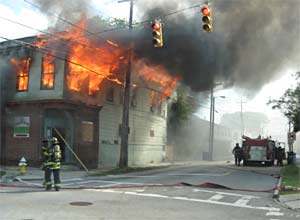Lessons Learned from Structure Collapse Close Call in SC
By Christopher J. Naum, SFPE on Dec 29, 2010 with Comments 0
Five firefighters were on the second story of a house when the floor tilted, causing three firefighters to fall
On June 23, 2010 Engine 109 was dispatched for a single engine response to the area of 398 Huger Street for a report of smoke in the area. Upon arrival at 0949 hours Engine 109 found heavy smoke and fire showing from the second floor of a two story “taxpayer type” structure at 398 Huger Street (corner of Rutledge and Huger).
The captain of Engine 109 requested a full first alarm response from dispatch and initiated a forward lay from a hydrant located at the intersection of Huger Street and Dewey Street. A unit from the Charleston Police Department was on scene and told the captain of Engine 109 that the upstairs part of the building was occupied by five people, but they were all out of the structure.
Engine 109 pulled a 2.5 inch hand line and started an exterior attack on the building after a water supply was established. Power lines and street lights at the intersection of Rutledge and Huger caught on fire and dropped to the ground.
After knocking down the fire from the exterior, Engine 109 pulled two 1.5 inch attack lines and Tower 104’s crew forced the door to gain entry to the second floor. Tower 104 conducted a primary search of three rooms and Engine 109 extinguished the remaining fire.
Realizing the top floor was divided into two separate apartments Tower 104 exited the first apartment on the alpha side (Rutledge) and made entry on the delta side apartment (Huger). After the fire was knocked down crews rotated in and out of rehab.
The local utility company arrived on scene to check and secure the fallen power line. The incident commander noticed the roof looked like it was getting ready to collapse and advised dispatch to set off the emergency evacuation tone; all units exited the structure and transitioned to a defensive mode. A PAR was conducted and all members were accounted for.
After an evaluation from the crews that were operating on the second floor about the condition of the roof command returned to offensive operations. During this part of the operation only two companies performed salvage and overhaul on the second floor at a time.
As Engine 111 crew worked on the second floor there was a clear indication that the floor area was weak as it was indicated that an area around a chimney had dropped about one foot. Engine 111 passed this information to command and to Engine 115 which was relieving them. There was a misunderstanding between the radio report and the orientation of the collapse location.
With Engine 115 operating in a 10 x 10 room on the second floor near the chimney the floor collapsed.
The collapse prompted a Mayday transmission from a crew member on the exterior. All units were instructed to switch to Fireground Channel 4 except for the units involved in the Mayday, the RIT team and the incident commander.
Three members of Engine 115 were involved in the collapse, one grabbed a window and exited head first onto a ground ladder, one fell to the ground with the collapse debris, and a third grabbed the doorway and was pulled to safety by Battalion 103 and the crew members of Engine 102. A ground ladder was lowered to rescue the member that fell to the first floor with the collapse.
After the Mayday was cleared a PAR was conducted and all members were accounted for. The three members involved in the Mayday remained on duty after being treated by EMS and reporting to rehab.
Lessons learned from this incident about the building include balloon frame construction contributed to the spread and intensity of the fire. Conditions that led to the collapse included fire damage, added weight from water, the condition of the building which had significant damage from termites and moisture. The exterior wall on the delta side of this structure was bowed towards the street in the approximate location of the collapse.
Following the fire Chief Carr appointed a group of fire service personnel from the Charleston and North Charleston Fire Department to initiate a critical incident review of this call. One of the recommendations that came from the review was: once an area has been identified that could cause further harm to firefighters, every effort should be made to keep personnel clear of the area.
A proper risk/benefit analysis of the incident needs to be conducted on a frequent basis. Short of a life safety issue, personnel safety shall not be risked in such conditions. There should be a clear understanding between the Command Post and personnel regarding specific location and the magnitude of hazards. A building inspector shall be notified whenever an area of a building has the potential of collapse.
Posted on FireRescue1.com By Battalion Chief Joseph Roberts/Charleston (SC) Fire Department
Filed Under: BuildingsonFire • Combat Fire Engagement
























